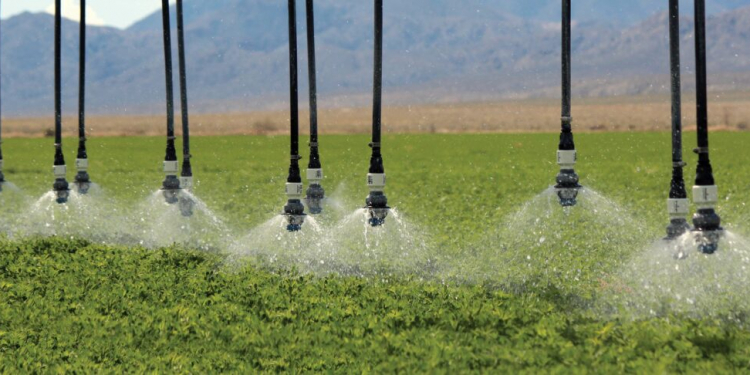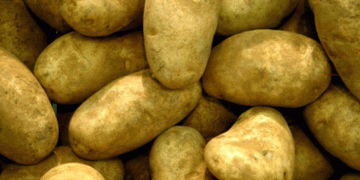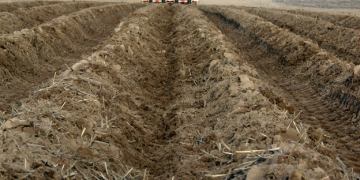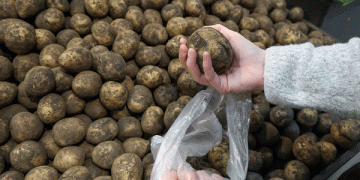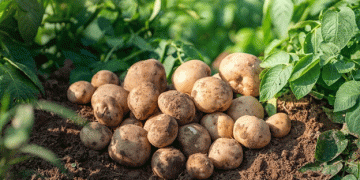Without irrigation, profitable potato production would be unlikely in low rainfall regions. Proper season-long soil moisture is the key to maximizing tuber yield, quality and grower return.

n well-drained soils, it is difficult to over-irrigate potatoes during early-season rapid canopy growth, as healthy plants consume water almost as quickly as it is applied. As the potato canopy matures mid-season, plant consumption drops significantly, but proper irrigation is still essential. Once the potato canopy is fully developed, about mid-July in central Washington, the plant shifts its priority from vegetative growth to tuber bulking.
Between the plant growth stages of tuber bulking to maturity, we researched these questions:
- How much water does a fully developed plant (peak of canopy and root mass) need?
- At what point does late season irrigation become excessive?
- Do cultivars respond similarly?
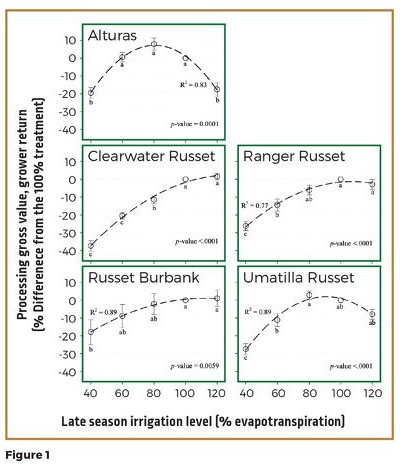
Research methods
Each year from 2018-20, we planted five potato cultivars — Alturas, Clearwater Russet, Ranger Russet, Russet Burbank and Umatilla Russet — near Othello, Washington, and produced them using grower-standard irrigation between emergence and midseason. Grower-standard irrigation was delivered at 100% of evapotranspiration (ET), estimated using the Washington State University’s (WSU) irrigation scheduler web-based program.
Once the plant canopy and roots peaked in growth — estimated at 1500-growing degree days (base temperature of 45℉, with upper limit of 95℉), which was between 95 and 105 days after planting (DAP) — five levels of irrigation were applied on all cultivars: 120% ET, 100% ET (considered the grower standard), 80% ET, 60% ET and 40% ET. The irrigation treatments continued until vines were killed or dead (~150 DAP), and the soil was kept moist until harvest. Tuber yield and quality were assessed and grower return calculated using a standard french-fry processing contract.
Results and discussion
(Due to page space considerations, not all data is shown.) Total yield for the four non-Alturas cultivars peaked at 100% ET, while Alturas peaked at 80% ET. Irrigation exceeding 100% ET failed to significantly improve total yield across cultivars. Late-season irrigation levels below 100% ET led to total yield reductions of up to 26% across cultivars. Process adjusted gross was optimized by irrigating between 80% ET and 100% ET for all cultivars (see Figure 1).
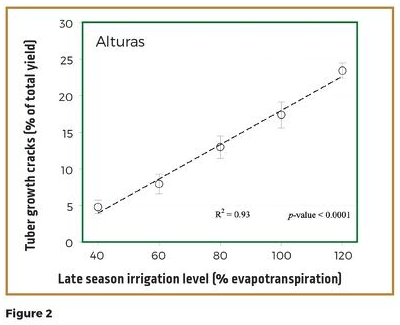
Alturas and Umatilla Russet gross return peaked when late-season irrigation was applied at or above 80% ET. Gross return was maximized with 100% of ET replacement for Clearwater Russet, Ranger Russet and Russet Burbank (Figure 1). At 40% ET, gross return was reduced by up to 38% for Clearwater Russet and less than 30% for the other cultivars. Process adjusted gross was typically reduced due to a loss in marketable yield and tuber quality.
As irrigation level declined, the percent of total yield comprised of U.S. No. 1 grade tubers increased; higher irrigation levels essentially led to larger, uglier tubers. As an example, Alturas plants produced more growth crack afflicted tubers as irrigation levels increased (Figure 2). Close to 25% of Alturas tubers contained growth cracks when irrigation was excessive (120% ET).
Another factor affecting gross return for all cultivars was a loss in specific gravity as irrigation levels increased (Figure 3). Plants receiving less irrigation, produced tubers with more dry matter than those under higher irrigation levels. French fry color for all cultivars was reduced as irrigation levels increased during the last half of the season; however, not all cultivars experienced the same loss in fry color, nor was it always significant to market acceptance.
Conclusions
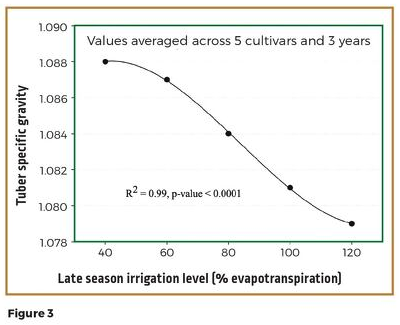
Avoiding excessive irrigation during the last half of the season will improve tuber quality and reduce growth cracks (Alturas). All cultivars produced the best economic return and yield when cultivars were irrigated at or above 80% ET from mid-season to vine kill. We recommend Alturas growers drop from 100% ET to 80% ET during the last four to six weeks of growth leading up to vine kill. This should lead to optimum grower return by maintaining yield and specific gravity while minimizing tuber growth cracking.
For Clearwater Russet, Ranger Russet and Russet Burbank, we recommend mid to late-season irrigation of 100% ET, and Umatilla 80-100% ET, until about three weeks prior to vine kill/predicted plant death. Three weeks prior to harvest, we recommend growers cut back to 80% ET to allow plants and tubers to mature naturally.
Reducing late season irrigation may also lead to improved tuber storability due to a reduction in diseases and associated rot, which may develop as tubers sit in moist or wet soils awaiting harvest. Moreover, the sudden decrease in available soil water late in the season is critical to maximize maturation-induced effects. Although not exact, 100% ET is often equivalent to a soil water content with a range 80-100% of field capacity during active irrigation and plant growth. Available soil water at 80% ET is approximately 65-70% of field capacity.
The authors thank the Northwest Potato Research Consortium, Washington State Potato Commission and industry, and Washington State University for funding this project. Francisco Gonzalez conducted this research in pursuit of his Ph.D. under direction of Mark Pavek, Washington State University Potato Research Group.
